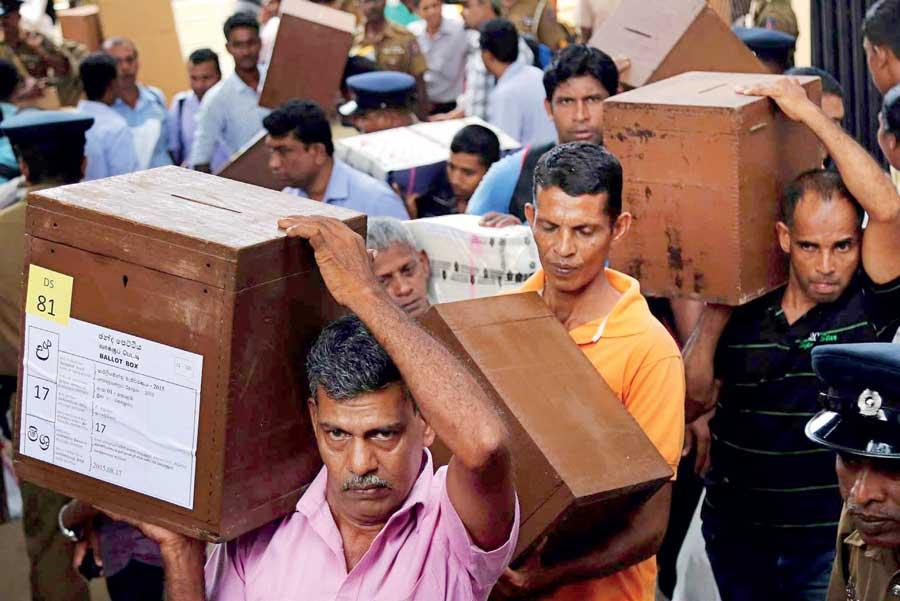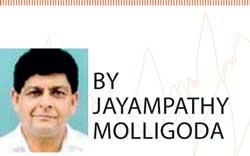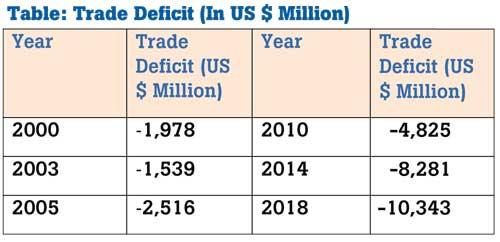29 Aug 2019 - {{hitsCtrl.values.hits}}

 The common belief among the public is that there has to be a radical change in the current economic policies and work programmes undertaken during the last four and half years, as the overall economic growth has drastically reduced. Consequently, the living conditions of the people have
The common belief among the public is that there has to be a radical change in the current economic policies and work programmes undertaken during the last four and half years, as the overall economic growth has drastically reduced. Consequently, the living conditions of the people have
badly affected.
At the same time, the perception of a vast segment of the floating voters is that some of the economic activities undertaken by the previous administration have also not yielded results, such as few infrastructure projects, continuous losses of the SriLankan Airlines, etc. and benefits have not filtered down to
ordinary masses.
One of the criticisms against the Mahinda Rajapaksa government was that it had resorted to heavy borrowings from foreign countries and multilateral lending institutions, especially from the People’s Republic of China, under the guise of seeking funds for infrastructure development work.
However, contrary to popular belief, the Central Bank annual report 2018 revealed that the Chinese outstanding foreign loan figure was only Rs.726 billion – out of the total foreign debt of Rs.5,960 billion, which is only 12.2 percent of the total foreign debt.
On the other hand, the interest rates offered by Chinese counterparts on such loans are much higher than that offered by multi-lateral agencies. According to the Institute of Policy Studies, those infrastructure projects implemented in partnership with multilateral agencies perform relatively better than those efforts managed solely by governments.
The bottom line is, by end-2018, the total government debt as a percent of gross domestic product (GDP) has substantially increased to 83 percent, as against 71 percent as at December 2014. In other words, the total central government debt figure stood at Rs.11,978 billion, when compared with the GDP of Rs.14,450 billion at market value (US $ 88.9 billion). The external debt as a percent of GDP in 1977 was only 21 percent and now it’s 59 percent.
Sri Lankan economy and political system, both at cross roads
Consequent to ‘Black-Easter Sunday’ terrorist attack, the economic activities have further deteriorated and the GDP growth rate for the current year is predicted below 3 percent. As we are witnessing, the Sri Lankan external sector performance, to be more specific, the ‘balance of trade’ position, remains a critical issue. This is mainly due to a steady deterioration in the ‘competitiveness of the exports’ coupled with low productivity and lack of consistent policies and implementation snags, red tapes, etc.
The total outstanding foreign debt position stood at US $ 52 billion by end-2018, compared with US $ 43 billion as at end-2014.
As per the Central Bank report 2018, the government spent 1.9 percent of GDP on education and the corresponding figure for health is only 1.5 percent of GDP in 2018.
Despite raising the tax rates, the government revenue declined to 13.3 percent of GDP in 2018 and consequently, the government had reduced the capital expenditure on public investment, contributing to a dampening of the
economic activity.
The state-owned enterprises losses including the Ceylon Electricity Board, Ceylon Petroleum Corporation and SriLankan Airlines have increased.
Despite having a substantial reduction of public investments in both physical and social infrastructure, a total sum of US $ 23. 5 billion has been additionally borrowed from foreign sources during the last four- year period, whereas only US $ 14 billion has been settled during the period under review.
Total public debt outstanding as at December 2018 was Rs.13,182 billion (increased to 91 of GDP), each citizen of Sri Lanka is already mortgaged up to a sum of Rs.607,470 per person.
Less than 100,000 elites/families including ‘new rich’ politicians and unscrupulous ‘business deal-makers’ in society have amazed substantial amount of wealth, whereas 60 percent of the people are either poor or lower middle-income category. (Source: Central Bank Reports)
Politics matter; professionals don’t see eye to eye on many matters
Some people take up the position that politics is something that should be left to the career politicians only. However, the democratic decision-making requires knowledge and practical experience: asking professionals, academics, entrepreneurs and ordinary people their views and ideas enables their opinion to be registered in the governance system. In short, democracy should give ordinary people a say in the affairs that govern their lives.
Politics matters because collective decisions matter. Politics matters because there are conflicts and differences of perspective in society about what to do, what resources to collect and allocate, how to spend and how to redistribute wealth and other resources through taxation
and subsidies.
Also, it is important to ascertain how to put in place a system of governance to determine such national policies that could be implemented efficiently and effectively. For almost everyone, what happens in the wider society makes a huge difference to their ability to get a job, access to better housing, health and educational facilities for their children, etc. You don’t have to be a career politician and you don’t even have to be socially gifted and coming from a political family and you don’t have to be wealthy.
Every individual, including the poor rural farmer or an urban construction worker, affected by a decision of the political authority, should have an equal opportunity to participate in that decision-making process. Unfortunately, there seems to be no system in place to capture this in a systematic manner, although it’s easier said than done.
There is an emerging positive trend with the recent decision by the Sri Lanka Podujana Peramuna (SLPP) leader, former president Mahinda Rajapaksa to nominate former secretary Gotabhaya Rajapaksa as the next presidential candidate of the party and subsequent chain of events. He is considered as a visionary leader with a proven track record.
It was reported in the media recently, even after the SLPP announcement, that his rival politicians have been praising him as a very effective and efficient administrator. The SLPP has proved as the largest and most popular single party in Sri Lanka. In addition, many professional groups affiliated to other political parties, directly or indirectly, are emerging nowadays that actively engage in national policy reviews, which is a good sign.
Recently, Megapolis Minister Patali Champika Ranawaka has presented his party’s vision and policy statement, whereas the Janatha Vimukthi Peramuna and National People’s Movement, a new political movement consisting of professionals and academics, are also engaged in national policy studies with a view to presenting a comprehensive set of national policies for consideration.
As one eminent retired central banker pointed out to this writer, no professional will be voted in by the people in this country, no matter how fed up they are with the present ‘elite politics’. This is because many professionals do not have a political base. Also, the professionals don’t see eye to eye on many matters.
This government had many professionals holding almost all professional posts but they support the governing party disregarding right and wrong. This happened in the previous government and may apply and relate to the next administration as well. Political engagement, participating in the national policy shaping exercise by professionals is good.
However, in my view, the professionals and academics who are engaged in review studies and policy formulations must adopt a sound ‘research methodology’, which includes focus-group discussions, a comprehensive ‘literature review’ of the subject matter and a sort of consultative process among the ordinary people, in order to ascertain the real issues faced by the people and society, before finalising their respective policy framework.
Visionary political leadership matters and a proper system and procedures, including HRD/ICT
There is a debate that even at the next general elections, there is a strong possibility that the political parties would be compelled to offer nominations to such politicians who have not delivered results and/or acted against the needs and aspirations of the ordinary people. Therefore, a popular suggestion is that some professionals and academics should be given nominations either from recognised political parties or
independent groups.
One could still argue that there is no guarantee that these so-called professionals, academics, etc. will not be tainted with their personal agendas, disregarding the grave need to fulfil people’s aspirations. This is where a visionary political leadership matter and a proper recruitment and selection method and a human resource development (HRD) strategy must be in place together with the use of ICT such as ‘e-governance’.
Further, a proper system should be in place to monitor and review implementation of the government authority after obtaining negative feedback from the people in a more structured and transparent manner.
A Sri Lankan expert on e-governance and telecommunication systems, who migrated to Australia, has recently sent this writer a mail, which is reproduced below.
“I also wanted to have a common database platform for digital data sharing for government agencies. Right now, different government agencies spend billions of funds on same data. As a result, different agencies have the same set of data. I don’t want any agency to own data. I want a central place – the government itself – to manage the data and it can be released to any agency upon request.
I will give you a simple example. Nara owns valuable data on deep sea. I could remember Megapolis spent millions of rupees to get these data. Similarly, there are other agencies wanting the same data. That agency has to spend money to buy that too. This should not be the case if it is owned by a central place. I know for a fact that lots of government projects got delayed because they did not have access to data on time.”
China’s BRI initiatives, 21st century maritime silk road and IOR
Coming back to geo-political realities in the region, I recall, during the 2006-2009 period, India supported the Mahinda Rajapaksa government and wanted the LTTE defeated despite the objections from the ‘Tamil Nadu’ political leadership. Since then, the Indo-Sri Lanka ‘bilateral’ relationships were seen going through a bad patch until the United National Front (UNF) government came into power in January 2015.
As articulated by Bandu De Silva, an eminent career diplomat, under the ‘Panikkar Doctrine’, Sri Lanka was conceived as essential for India’s forward defence system in the direction of Indian Ocean. One can argue that Mahinda Rajapaksa administration had failed to dispel India’s concerns about growing tie-up between Sri Lanka and China and how it impacts India’s
national security.
The situation has changed since the UNF government came into power. However, India is sceptical about the present government’s decision to handover the Hambantota port to a Chinese company on a 99-year lease.
The Indian Ocean Region (IOR) is widely regarded as the hub of global economic and strategic activities for several reasons. For instance, it provides the predominant outlet for oil from the Persian Gulf to various destinations across the globe. More than 80 percent of global oil trade passes through the IOR.
The United States, UK and West are now concerned that China would emerge as the super-power status economically, thus dominating the IOR economically as well as a militarily power-base later. The ultimate goal of the United States of America may be to regain full control and dominance over the IOR. In order to achieve that, they need to ensure that the emerging Asian countries like India, China, Sri Lanka and Pakistan would not get together, thus forming some kind of a ‘regional alliance’. This can only be done through creating division among those countries.
The first strategic move somewhere in 2012 by the US was the signing of the accord with India to enhance defence cooperation. The second ploy was to make use of the alleged human rights violations and other ‘good governance issues’ to deliberately interfere with the internal affairs of the Government of Sri Lanka and annoy the leaders. The motive was to destabilise Sri Lanka through the mechanisms available under the UNHRC.
According to experts on international relations, India has recently initiated an unprecedented naval build up under its vision to turn the Indian Ocean into ‘India’s Ocean’. This is obviously to secure its strategic interests. A recent literature review reveals that India is allocating more and more of its budget to its naval war fighting capabilities and it wants to secure ‘sea-lines of communications’ to the Middle East, comprising the vital oil and energy supply chains.
India is not only strengthening its naval capabilities but also seeking to strengthen relations with smaller states within the IOR. These include Sri Lanka, the Maldives, Myanmar, Thailand, Bhutan, Bangladesh, Mauritius and the Seychelles. After securing a landmark victory in the 2019 general elections, Prime Minister Modi chose the Maldives and Sri Lanka as his first official visit abroad for this term, to consolidate India’s position in the Indian Ocean. Such choices clearly show India’s foreign policy priority in the IOR.
World Association of Political Economy Chairman Professor Cheng Enfu in a symposium held in Sri Lanka said that with the Indian Ocean being the lifeline of global foreign trade, energy and raw material transportation, Sri Lanka will undoubtedly play a crucial role in the strategy of the 21st Century Maritime Silk Road with its unique geographic advantage.
However, as can be seen above, the critical issue here is the ‘Indian interests’. The Indian foreign policy is based on a fundamental principle of “In diplomacy, there were no permanent friendships but permanent interests”. Sri Lanka is compelled to follow this principle governing Indian foreign policy to further strengthen bilateral relationship with India.
Conclusion
It seems that the present UNF government as well as the leaders of the SLPP headed by former president, Mahinda Rajapaksa are both trapped between the geo- economic realities, Geneva resolutions, internal conflicts of China and India and formulating best choices to fulfil the aspirations of the people of the country. It goes without saying that for Sri Lanka, balancing relations between the two neighbour countries, namely India and China, has been a daunting task.
In the circumstances, it is vital that the presidential candidates who aspire to become the seventh executive president of the Democratic Socialist Republic of Sri Lanka, engage in serious policy studies, in consultation with a multi-disciplinary team of experts, to come up with the best choices for the country taking into consideration the geo-political realities, especially in the ‘Indian Ocean’ or as some claimed, ‘India’s Ocean’.
(Jayampathi Molligoda is a Fellow Member of the Institute of Chartered Accountants of Sri Lanka and holds an FMIC Masters of Business Administration from the Postgraduate Institute of Management, University of Sri Jayewardenepura. He is currently CEO of Bogawantalawa Tea Estates PLC and can be contacted through [email protected])
23 Nov 2024 23 Nov 2024
23 Nov 2024 23 Nov 2024
23 Nov 2024 23 Nov 2024
23 Nov 2024 23 Nov 2024
23 Nov 2024 23 Nov 2024